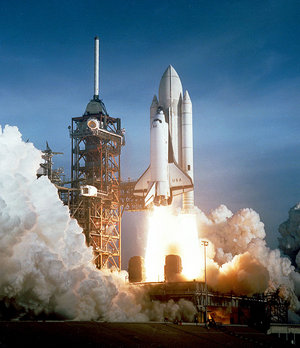Rocket Science for Secondary and High School students (ages ~14-18)
By Tony Hull
This question sheet is for Science students between the ages of 14 and 18, with an interest in Rocket Science. However, they may also be of interest to amateur rocket scientists everywhere.
First version created 16th February 1986 for year 10 students (age ~14) in a UK school. Web version created on 28th January 2006, the twentieth anniversary of the Space Shuttle Challenger disaster.

Table of contents
-
Introduction
-
Problems
-
Solutions
-
Further work
-
References, acknowledgements and copyright
2. Problems
Given the above, provide solutions to the following.
- Why does the ejection of gas from the engines produce a forward force on the system? (“System” = orbiter + 2 SRBs + external tank)
- Calculate the total momentum of the exhaust gases ejected in the first one second of firing, in kg m/s.
- Calculate the mass of the complete loaded system.
- Calculate the weight of the complete loaded system.
- Given that force X time = change of momentum, and therefore force = change of momentum / time, calculate the force on the system produced by all the engines together.
- What is the unbalanced force on the system, when the force due to the engines is directed upwards? (Note: force is a vector, so the direction must be specified).
- Calculate the acceleration of the system at lift-off (Note: Acceleration is also a vector)
- Calculate the acceleration of the system if the engines were fired with the system pointing horizontally.
- To get into orbit, a horizontal
speed of some 8000 m/s is required, so why is the system launched vertically?
- At 120 seconds after lift-off, when the SRBs are exhausted, the shuttle is 44 km above sea-level. What figure does this give for the average vertical acceleration during the first 120 seconds?
- Why is the average acceleration greater than the initial acceleration calculated in question 7?
- Make an estimate of the vertical speed of the system after 120s, using the approximation that acceleration has been steady.
- The exhausted SRBs, when released, are said to continue upwards for another 23km of height gain! What vertical speed does this indicate at the point of release?
- How well does your answer to question 13 agree with that to question 12?
- Justify an approximation you made (unconciously?) in question 13.
- By a calculation, show whether or not the Shuttle could get off the ground without the assistance of SRBs.
- 1450m3 of the liquid hydrogen fuel is pumped from the external tank to the oribiters main engines in 8.5 minutes, through a pipe 43cm in diameter. At what speed does the liquid hydrogen travel along this pipe?
- How high could this pump squirt a liquid hydrogen fountain?
- How many external-tank-loads of liquid hydrogen could be stored in a large room, e.g. room 44 (suitably modified) measures 3 X 7 X 13.5 metres?
- What conditions would you suggest for the storage of liquid hydrogen?
- The density of hydrogen gas under “normal” conditions is about 80 g / m3. The airship Hindenberg, which burned in 1936, was a lot bigger than the Shuttle System - the same height (50m) and 250m long. Its volume was 200,000m3. Which held more hydrogen, the Hindenberg, or the Shuttle External Tank?
3. Solutions
- Sample solutions are available by emailing anthonybrianhull at yahoo dot co dot uk.
4. Further work
DO try this at home!
- A cheaper, quicker and easier way to be a rocket scientist is to build your own water rocket. An empty lemonade bottle will do for your rocket. You can propel your spacecraft using a much less flammable and more abundant liquid called water and a mixture of gases called air, pressurised using a bicycle pump. It won't get your rocket into orbit, but its great fun. See The Leeds Water Rocket Page for further details.
5. References, acknowledgements and copyright

